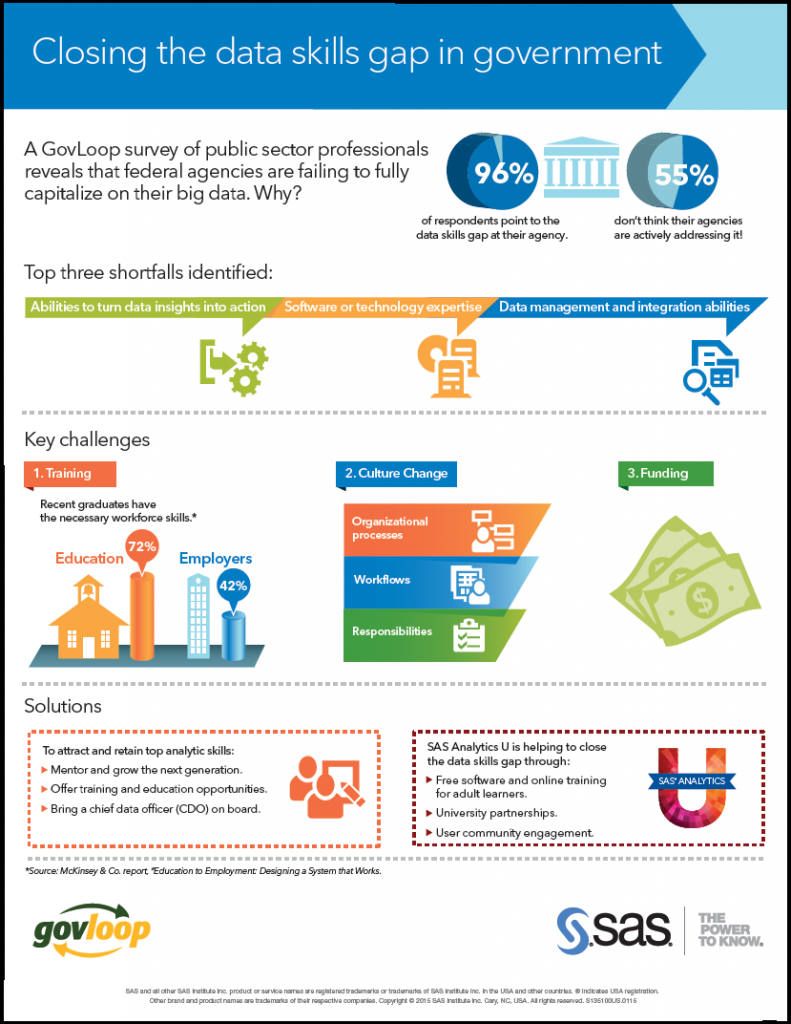Despite an increase in the availability of data in the federal government over the past few years, data and analytics could be doing even more for federal agencies. A strategic approach to managing and analyzing the data is needed. And, like many technology challenges – that’s a people problem.
A new GovLoop report, Government Workforce in Focus: Closing the Data and Analytics Skills Gap, surveyed 283 public sector professionals and found that despite collecting, storing and managing volumes of data as they perform mission-critical activities, federal agencies fall short in turning the information into insight. This is due, in large part, to a critical skills gap.
 The GovLoop report indicates that while the federal workforce is increasingly basing decisions on data, it lacks the data and analytics skills to translate complex data sets into useful knowledge for decision-makers. Most respondents (78 percent) called data a significant component of their jobs, and 60 percent scored their use of data to make decisions “above average.” But a stunning 96 percent (46 percent of whom self-identified as experts or analysts) identified a data skills gap at their agency.
The GovLoop report indicates that while the federal workforce is increasingly basing decisions on data, it lacks the data and analytics skills to translate complex data sets into useful knowledge for decision-makers. Most respondents (78 percent) called data a significant component of their jobs, and 60 percent scored their use of data to make decisions “above average.” But a stunning 96 percent (46 percent of whom self-identified as experts or analysts) identified a data skills gap at their agency.
In order to become a more data-driven and efficient government, it is imperative that we address the critical gaps identified in the report:
- Inadequate training. The report, citing a McKinsey study, revealed a disconnect in the perceptions of educational institutions and employers. While 72 percent of educational institutions are confident that recent graduates have the necessary skills for the workforce, only 42 percent of employers agree.
- Evolving norms/Inaccessible data. To adequately use data requires a shift in thinking about organizational processes, workflows and responsibilities. Survey respondents want to see fewer stovepipes of data that isn’t shared across the enterprise. In addition, data is maintained in several disparate locations and is not easily integrated using existing systems and tools. In fact, 74 percent of respondents identified “better integration of data sources” as the skill they needed most.
- Insufficient funding. Although respondents identified funding to modernize IT solutions and invest in analytical training as major challenges, 55 percent doubted their agencies were actively addressing the data skills gap.
This report is a wake-up call for the entire federal community – agencies, Congress and contractors, as well as the educational institutions that feed new talent into the federal workforce. These are not impassable roadblocks, but they do need to be dealt with, and quickly. But that requires strategic, top-down leadership, which could be addressed through the addition of a Chief Data Officer at each federal agency to reexamine each agency’s approach to data, as well as chart the course for adding more data scientists to agency rolls.
There is some good news. Just last week, the White House took the landmark step of appointing the nation’s first Chief Data Scientist to the Office of Science and Technology Policy. The Centers for Medicare & Medicaid Services recently took a step in the right direction with the appointment of Niall Brennan, their first-ever Chief Data Officer. Similarly, the Department of Commerce, Federal Reserve Board, National Institutes of Health and the Federal Communications Commission all have Chief Data Officer roles.
While their charters likely vary by individual agency, the basic goal for each of these new appointees remains the same: Treat data as a strategic asset. It should be analyzed to generate new insight and inform better decision-making in support of the agency’s mission. That includes ensuring each agency has the data scientists and analytics capabilities to understand the significance of the data.
Many nations around the world are striving to harness big data by producing talent that can use the latest in analytics technology. The U.S. is making some progress, but these efforts must be accelerated. Unless the U.S. federal government dedicates resources to focus on data and analytics leadership, and makes a serious effort to overcome the federal workforce data and analytics skills gap, our nation will grow increasingly uncompetitive in the global community.

